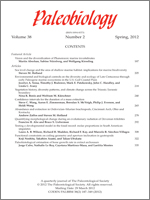A basic hypothesis in extinction theory predicts that more abundant taxa have an evolutionary advantage over less abundant taxa, which should manifest as increased survivorship during major extinction events and longer fossil-record durations. Despite this, various paleontologic studies have found conflicting patterns, indicating a more complex relationship between abundance and extinction in the geologic past. This study tests the relationship between abundance and extinction among brachiopod genera within seven third-order depositional sequences spanning the Late Ordovician to Early Silurian (Katian–Aeronian) of the Cincinnati Arch.
Contrary to predictions, abundance is not positively correlated with duration in this study. Abundance and duration range from strongly negatively correlated to uncorrelated depending on the spatial scale of analysis and the geologic intervals included, but correlations never indicate that abundance is an evolutionary advantage. In contrast, abundance was an advantageous trait prior to the Ordovician/Silurian extinction, and brachiopods with higher abundances were more likely to survive the event than less abundant brachiopods. While this result is in keeping with common models of extinction, it has not been observed previously at a mass extinction boundary. This may be further evidence that the Ordovician/Silurian extinction was not accompanied by a shift in the macroevolutionary selectivity regime.





